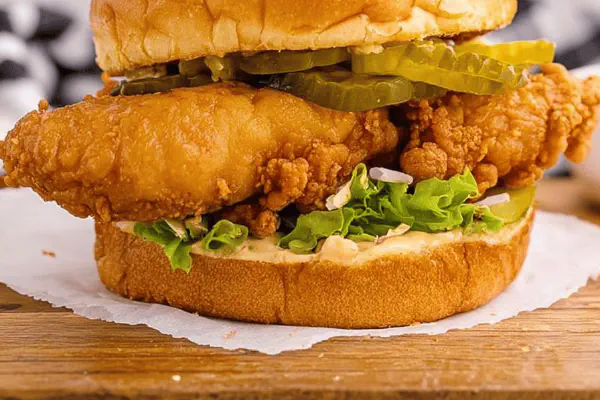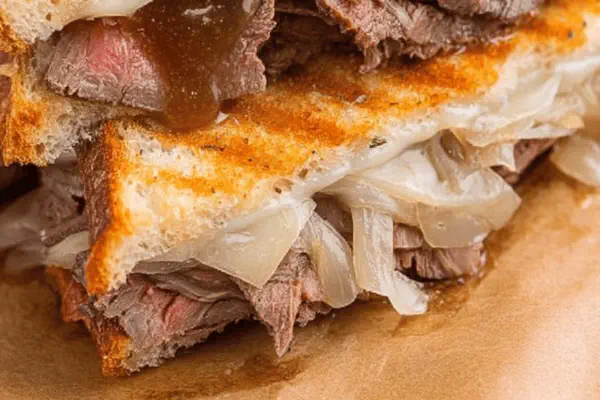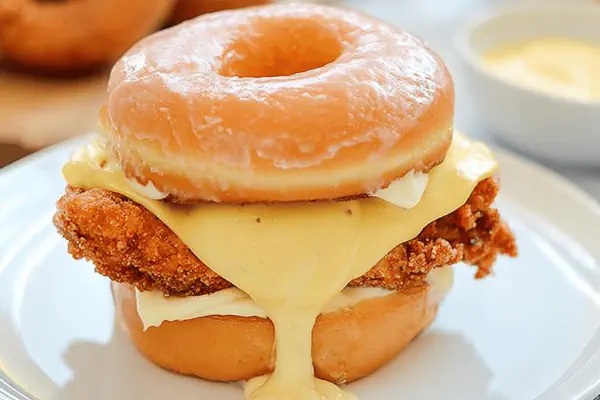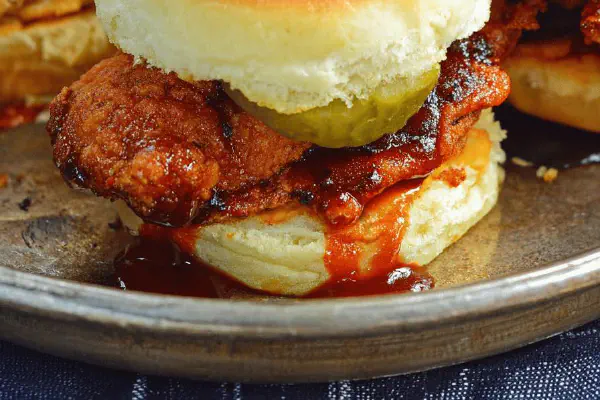Twice-Dipped Fried Chicken Sandwich

By Emma
Certified Culinary Professional
Ingredients
- 3 large chicken breasts sliced in half horizontally
- 1 1/4 cups buttermilk
- 2 tablespoons hot sauce such as Franks
- 1 tablespoon dill pickle juice
- 1 1/2 cups all-purpose flour
- 1 1/2 teaspoons fine sea salt
- 1 teaspoon freshly ground black pepper
- 1 teaspoon smoked paprika
- 1 teaspoon garlic powder
- 4 inches vegetable oil for frying (canola or peanut oil preferred)
- 6 brioche buns
- 2 tablespoons butter softened
- 6 dill pickle slices
- For sauce twist: mix 1/4 cup mayo, 1 teaspoon Dijon mustard, 1 teaspoon honey, dash cayenne
About the ingredients
Method
- Start banging the chicken breasts between parchment paper sheets with a meat mallet until about half an inch thick. Maintain uneven edges for texture. Then slice breasts horizontally to get two smaller pieces for each.
- Whisk buttermilk with hot sauce and pickle juice in a bowl. Toss in chicken. Let it soak minimum 20 minutes; this tenderizes and builds flavor. Usually I leave it 25.
- While waiting, combine flour, salt, pepper, smoked paprika, and garlic powder in a shallow dish. Shake well to avoid clumps—seasoning balance here is key for crunch and taste.
- Heat deep oil in a Dutch oven or heavy pot; minimum depth 4 inches, ideally 6 to allow full submersion. I use peanut oil because of high smoke point and neutral taste. Bring temperature to a steady 350°F; takes about 18 minutes on medium-high heat. Use a candy thermometer for accuracy. Oil too hot scorches crust, too cool sucks oil inside making soggy chicken.
- Remove chicken from buttermilk bath, let excess drip off. Coat both sides in flour. Then dunk once again in buttermilk briskly, then back into flour for a double dredge. This layering locks in juiciness and guarantees crispy crust.
- Carefully lower one piece into hot oil. Should hear steady crackle — not frantic sputter. Fry around 5-6 minutes total, flipping halfway, until crust is a deep golden brown and an internal thermometer hits 165°F. Avoid crowding pot to keep temperature steady. If oil drops below 340°F, crust becomes greasy.
- Drain fried chicken on paper towels or used brown paper bags for oil absorption. Avoid stacking pieces; they steam and lose crispness.
- Meanwhile, prep buns. Cut and open each one, spread with softened butter. Lay them face-up on a rimmed sheet; broil 2-3 minutes on high until just toasted, edges crisped but not burnt. Watch closely, ovens vary.
- To serve, place couple dill pickle slices on bottom bun. Stack fried chicken, then slather a spoonful of zesty sauce — mayo mixed with Dijon, honey, and a pinch cayenne adds unexpected sweet-heat contrast. Crown with top bun.
- Best hot and freshly assembled; give napkins or wet wipes close by—oil and crispy crumb can be messy but worth every bite.
Cooking tips
Chef's notes
- 💡 Pound chicken unevenly on purpose; thin center cooks fast but rough edges add chew texture. Use parchment to keep clean. Slicing breasts horizontally makes smaller pieces, quicker cook, better layering—don’t skip.
- 💡 Double dredge works magic. Flour then buttermilk then flour again seals juices. Skip double coat, crust turns blotchy or soggy. Use shallow dishes to move fast; avoid clumps by shaking seasoning well before flour.
- 💡 Pickle juice in buttermilk? Adds acidity, tang. Acid breaks down proteins, tenderizes deeper than buttermilk alone. Keep soak time 20 to 25 minutes max; too long turns chicken mushy, too short no juice lock.
- 💡 Oil temp steady at 350°F crucial. Too hot scorches crust fast, taste burnt. Too cool soaks oil in chicken, greasy mess. Use candy thermometer every batch. Oil type matters; peanut or canola has high smoke, neutral flavor. No EVOO, burns too fast.
- 💡 Watch sound when frying: steady crackle means right heat. Wild sputter means too hot. Flip gently or press, otherwise juices leak and dry meat. Use slotted spoon or spider, don’t crowd pan. Crowding drops temp, crust suffers.
- 💡 Toast buns under broiler quick—2 to 3 minutes tops. Spread softened butter so edges crisp but not blackened. Look for golden edges, not full brown. Charred bits taste bitter, bad contrast with sweet-salty sandwich.
- 💡 Sauce mix: mayo, Dijon, honey, cayenne dash. Skip mayo, sandwich feels dry really fast. Honey balances heat. Make fresh or store cold because honey can separate. Sauce adds creamy kick, cuts richness. Optional but highly advised.
- 💡 Drain fried pieces on paper towels or brown paper bags if no towels; avoid stacking to keep crisp. Stacking steams crust, turns soggy fast. Eat soon after frying or hold warm in low oven but crust softens if too long.
Common questions
Can I use chicken thighs?
Thighs heavier fat, cook uneven. Pound thinner or butterfly if possible. Skin off messier crust but moister meat. Adjust frying time; thighs longer than breast halves usually.
What if no pickle juice?
Use plain yogurt thinned with a splash vinegar or lemon juice. Not exact but acid matters for tenderizing. Skip hot sauce if you want milder flavor; or swap with sriracha for heat shift.
Chicken crust soggy, why?
Usually oil too cool, crumbs soak oil. Or crowded pot drops temp mid-fry. Double dredge locks crust; skip it crust weaker. Drain on paper towels immediately; no stacking or moisture traps inside crust.
How to store leftovers?
Wrap cool chicken tightly; oven reheat preferred to keep crust crisp. Microwave makes crust mushy. Sauce separate – keep separate container. Buns toast again or use fresh for better crunch next day.



